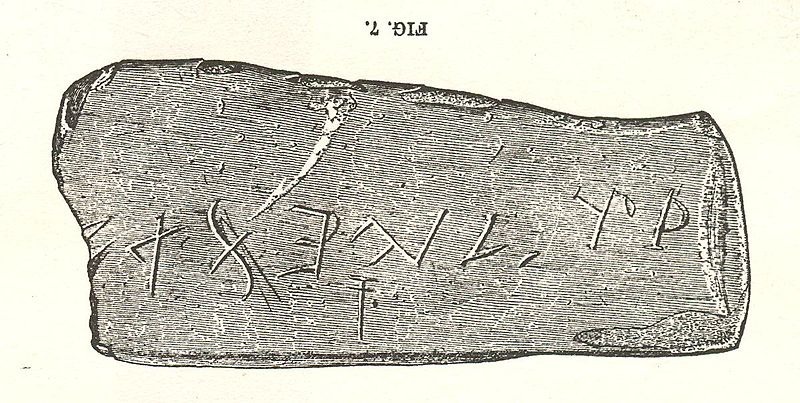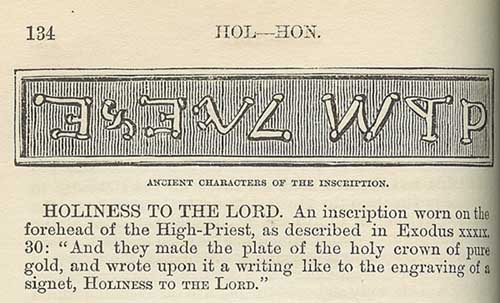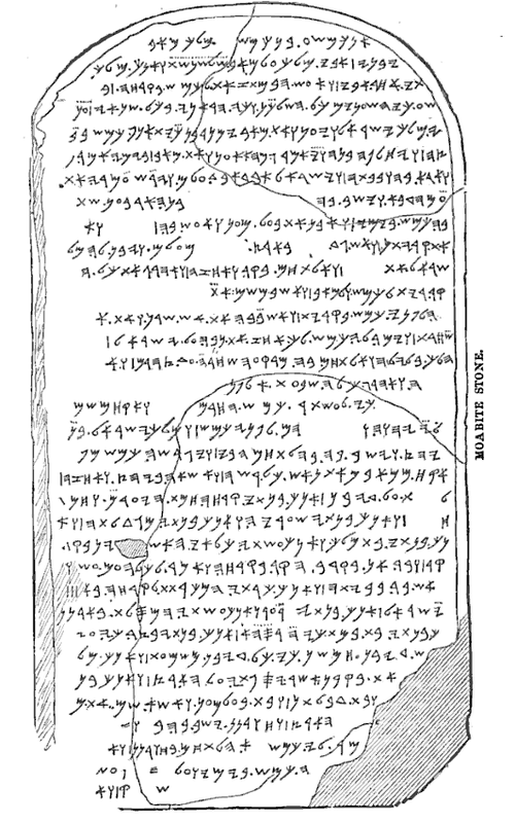|
In the comments section of my blog, longtime advocate of the authenticity of the Bat Creek inscription J. Huston McCulloch takes me to task for failing to address several points about the inscription in my earlier review of a chapter from Lost Worlds of Ancient America in which geologist Scott Wolter attempted to analyze the stone, found in 1889, which supposedly contains an ancient Hebrew text. In my review, I discussed earlier scholars’ work pointing to the close similarity between the Bat Creek inscription and a reconstructed paleo-Hebrew text appearing in an 1868 Masonic text, Robert Macoy's General History, Cyclopedia and Dictionary of Freemasonry. McCulloch, like the diffusionist linguist Cyrus Gordon before him, points to the small comma- or dot-shaped mark appearing between the two words. This, he says, is a paleo-Hebrew word-divider. Since this divider does not appear in the Masonic reconstruction, McCulloch argues that the text could not have been copied from the Masonic image. The fact that the inscriber had knowledge of paleo-Hebrew word division therefore strongly implies that the stone was genuinely ancient. “There is,” McCulloch wrote in 2010, “no way this subtle detail could have been copied from Macoy's illustration, even if the copyist threw in a few random changes to disguise his or her source.” As William F. McNeil put it in 2005 in Visitors to Ancient America, “The word divider is an important clue to establishing the authenticity of the stone because it was not known until well into the twentieth century.” But is this the case? It is not entirely clear to me that the mark is a word divider at all, since there is a quite obvious space between the two words. Word dividers, not consistently used in ancient Hebrew, were intended to divide words without the need for spaces. But let’s assume that it is a word divider. Does this prove that the inscription could not have been faked from Masonic texts? No, it does not. In 1868, a stele of the Moab king Mesha recording a victory over Israel was found in what is now Jordan. Known as the Moabite Stone in the nineteenth century and today as the Mesha Stele, it caused a sensation because it contained the earliest pre-Biblical reference to Yahweh, the Israelite god. This stone was extensively discussed in the Masonic literature. In the 1870 book Freemasonry in the Holy Land, published in the United States and distributed to Masonic lodges, Robert Morris makes two important statements about the Moabite Stone that directly impact whether a Masonic forger could have placed a word divider in the Bat Creek inscription. First, the Moabite inscription proved, he said, that “the Semitic alphabet was the Phoenician” due to the strong similarities. (Cyrus Gordon, McCulloch’s predecessor, later identified the Bat Creek alphabet as “Caananite.") Second, he stated that “punctuation was carefully observed in old writings, so far as to separate by marks both words and sentences.” The following image or the Mesha Stele, from his text, demonstrates that the style and shape of the letters, along with word divider marks, were well-known in the 1870s and 1880s and was thus not a twentieth-century discovery. The divider on the Bat Creek inscription is correctly placed in the bottom right corner of the word, as it is on the Moabite Stone. Note, too, that the characters on the Moabite Stone are an even closer match to those found on the Bat Creek inscription than in Macoy's Masonic text. The appearance of an extra character beneath the main line of text in the Bat Creek inscription mirrors the isolated characters in the drawing of the Mesha Stele. Finally, note that while on the actual basalt carving of the Mesha Stele the dividers are small circles, the pen and ink drawing from 1870 makes many of them appear elongated (such as the one right of center on line 24), giving the appearance of commas, like the one found on the Bat Creek Stone.
A reasonably perceptive forger would note that this new discovery superseded the reconstructed paleo-Hebrew of the 1868 engraving. It is a short step from there to adding a word divider and some random Maobite characters to make the forged inscription harmonize more closely with newly-established facts. Given that even Cyrus Gordon found some of the characters on the Bat Creek inscription “problematic” (the first two are uncertain, though to me they look like they were drawn from the Maobite Stone), it is not impossible that a forger used parts of Macoy's paleo-Hebrew drawing with extra characters from the Moabite Stone to compose a hoax text. Is this conclusive proof that the inscription is forged? No, but it removes one obstacle to declaring it a forgery as it can no longer be asserted that a Victorian forger with access to Masonic texts could not have known to use a word divider.
38 Comments
5/26/2012 02:27:00 pm
Good point, but in fact the Siloam inscription (discovered 1880 and published 1882 by H. Guthe in the Zeitschrift der Deutschen Morgenlaendischen Gesellschaft) is better, since it actually has Bat Creek type word dividers rather than simple dots like Mesha. It is true that one out of maybe 100 dividers on the drawing of the Mesha stele is a short vertical stroke, but obviously the dots are canonical, and even one stroke is vertical rather than diagonal.
Reply
7/10/2012 10:20:01 pm
Nice ancient stones and the sculpture is really beautiful and interesting.Thanks for the blog post.
Reply
11/25/2013 04:50:33 pm
As forgeries go, this one looks quite amazing to a layperson. In particular, the break seems very believable.
Reply
10/13/2015 10:50:12 pm
<a href="http://produkgreenworldoriginal.blogspot.co.id/2015/07/cara-meningkatkan-gairah-suami.html">cara meningkatkan gairah suami</a>
Reply
5/26/2016 11:33:51 pm
Friday is that it could be a blessing and thanks for the news .
Reply
6/16/2016 11:03:07 pm
Thanks for posting information about a very interesting will we wait for the other posts
Reply
7/18/2016 02:26:53 am
Though it's a holiday but this one website is always present information gratitude .
Reply
9/19/2016 12:14:46 am
Definitely get through it with passion? thank you for providing information of interest
Reply
10/26/2016 04:34:34 am
Definitely get through it with passion? thank you for providing information of interest
Reply
11/29/2016 08:06:00 pm
The information you present to this day, is meaningful at all for us for that we say many thanks.
Reply
12/30/2016 01:09:37 am
We say many thanks much for the information that you provide on this day.
Reply
1/30/2017 09:37:52 pm
Thank you very much for today because it serves a variety of interesting information.
Reply
3/23/2017 08:06:53 pm
I hope every day is always presented with information like this .
Reply
7/13/2017 03:00:49 am
Congratulations working again hopefully provide better information again thank you.
Reply
8/14/2017 02:07:23 am
Good morning thank you this morning has provided the best sites .
Reply
10/3/2017 03:52:25 am
Information on this day so very interesting thanks .
Reply
11/1/2017 02:37:44 am
Thank you very much for the information you present today.
Reply
12/17/2017 09:43:29 pm
We will wait for other sites that are good .
Reply
1/10/2018 10:56:42 pm
Salute really with this one website, because it always presents very interesting information.
Reply
1/30/2018 10:54:50 pm
Glad for today because the information is so useful from this site thank you very much.
Reply
2/23/2018 03:41:38 am
https://walatrasehatmata1.wordpress.com/2018/02/22/cara-menyembuhkan-daging-tumbuh-di-mata-tanpa-operasi/
Reply
3/29/2018 12:11:02 am
Good afternoon and welcome rest for a while? Thank you for providing such useful information.
Reply
4/20/2018 02:48:48 am
Very interesting information presentation.
Reply
6/29/2018 02:24:18 am
Reply
8/6/2018 04:02:35 am
Information that is always in waiting by the visitors.
Reply
8/11/2018 03:53:44 am
thank you because this article is very interesting and very helpful to me
Reply
8/16/2018 02:34:22 am
Besides being interesting, this information has a very constructive message for its readers
Reply
9/25/2018 09:14:03 pm
Information that is so very binding is a lot of visitors to listen to it.
Reply
12/8/2018 06:13:24 am
http://emc-mee.com/blog.html شركات نقل العفش
Reply
12/8/2018 06:14:26 am
Reply
12/8/2018 06:15:11 am
Reply
12/8/2018 06:15:48 am
Reply
12/8/2018 06:16:49 am
http://mycanadafitness.com/ شركة كيان لنقل العفش
Reply
3/6/2019 05:37:26 pm
Reply
Your comment will be posted after it is approved.
Leave a Reply. |
AuthorI am an author and researcher focusing on pop culture, science, and history. Bylines: New Republic, Esquire, Slate, etc. There's more about me in the About Jason tab. Newsletters
Enter your email below to subscribe to my newsletter for updates on my latest projects, blog posts, and activities, and subscribe to Culture & Curiosities, my Substack newsletter.
Categories
All
Terms & ConditionsPlease read all applicable terms and conditions before posting a comment on this blog. Posting a comment constitutes your agreement to abide by the terms and conditions linked herein.
Archives
July 2024
|
- Home
- Blog
- Books
-
Articles
-
Newsletter
>
- Television Reviews >
- Book Reviews
- Galleries >
- Videos
-
Collection: Ancient Alien Fraud
>
- Chariots of the Gods at 50
- Secret History of Ancient Astronauts
- Of Atlantis and Aliens
- Aliens and Ancient Texts
- Profiles in Ancient Astronautics >
- Blunders in the Sky
- The Case of the False Quotes
- Alternative Authors' Quote Fraud
- David Childress & the Aliens
- Faking Ancient Art in Uzbekistan
- Intimations of Persecution
- Zecharia Sitchin's World
- Jesus' Alien Ancestors?
- Extraterrestrial Evolution?
- Collection: Skeptic Magazine >
- Collection: Ancient History >
- Collection: The Lovecraft Legacy >
- Collection: UFOs >
- Scholomance: The Devil's School
- Prehistory of Chupacabra
- The Templars, the Holy Grail, & Henry Sinclair
- Magicians of the Gods Review
- The Curse of the Pharaohs
- The Antediluvian Pyramid Myth
- Whitewashing American Prehistory
- James Dean's Cursed Porsche
-
Newsletter
>
-
The Library
-
Ancient Mysteries
>
-
Ancient Texts
>
- Mesopotamian Texts >
-
Egyptian Texts
>
- The Shipwrecked Sailor
- Dream Stela of Thutmose IV
- The Papyrus of Ani
- Classical Accounts of the Pyramids
- Inventory Stela
- Manetho
- Eratosthenes' King List
- The Story of Setna
- Leon of Pella
- Diodorus on Egyptian History
- On Isis and Osiris
- Famine Stela
- Old Egyptian Chronicle
- The Book of Sothis
- Horapollo
- Al-Maqrizi's King List
- Teshub and the Dragon
- Hermetica >
- Hesiod's Theogony
- Periplus of Hanno
- Ctesias' Indica
- Sanchuniathon
- Sima Qian
- Syncellus's Enoch Fragments
- The Book of Enoch
- Slavonic Enoch
- Sepher Yetzirah
- Tacitus' Germania
- De Dea Syria
- Aelian's Various Histories
- Julius Africanus' Chronography
- Eusebius' Chronicle
- Chinese Accounts of Rome
- Ancient Chinese Automaton
- The Orphic Argonautica
- Fragments of Panodorus
- Annianus on the Watchers
- The Watchers and Antediluvian Wisdom
-
Medieval Texts
>
- Medieval Legends of Ancient Egypt >
- The Hunt for Noah's Ark
- Isidore of Seville
- Book of Liang: Fusang
- Agobard on Magonia
- Book of Thousands
- Voyage of Saint Brendan
- Power of Art and of Nature
- Travels of Sir John Mandeville
- Yazidi Revelation and Black Book
- Al-Biruni on the Great Flood
- Voyage of the Zeno Brothers
- The Kensington Runestone (Hoax)
- Islamic Discovery of America
- The Aztec Creation Myth
-
Lost Civilizations
>
-
Atlantis
>
- Plato's Atlantis Dialogues >
- Fragments on Atlantis
- Panchaea: The Other Atlantis
- Eumalos on Atlantis (Hoax)
- Gómara on Atlantis
- Sardinia and Atlantis
- Santorini and Atlantis
- The Mound Builders and Atlantis
- Donnelly's Atlantis
- Atlantis in Morocco
- Atlantis and the Sea Peoples
- W. Scott-Elliot >
- The Lost Atlantis
- Atlantis in Africa
- How I Found Atlantis (Hoax)
- Termier on Atlantis
- The Critias and Minoan Crete
- Rebuttal to Termier
- Further Responses to Termier
- Flinders Petrie on Atlantis
- Amazing New Light (Hoax)
- Lost Cities >
- OOPARTs
- Oronteus Finaeus Antarctica Map
- Caucasians in Panama
- Jefferson's Excavation
- Fictitious Discoveries in America
- Against Diffusionism
- Tunnels Under Peru
- The Parahyba Inscription (Hoax)
- Mound Builders
- Gunung Padang
- Tales of Enchanted Islands
- The 1907 Ancient World Map Hoax
- The 1909 Grand Canyon Hoax
- The Interglacial Period
- Solving Oak Island
-
Atlantis
>
- Religious Conspiracies >
-
Giants in the Earth
>
-
Fossil Origins of Myths
>
- Fossil Teeth and Bones of Elephants
- Fossil Elephants
- Fossil Bones of Teutobochus
- Fossil Mammoths and Giants
- Giants' Bones Dug Out of the Earth
- Fossils and the Supernatural
- Fossils, Myth, and Pseudo-History
- Man During the Stone Age
- Fossil Bones and Giants
- Mastodon, Mammoth, and Man
- American Elephant Myths
- The Mammoth and the Flood
- Fossils and Myth
- Fossil Origin of the Cyclops
- History of Paleontology
- Fragments on Giants
- Manichaean Book of Giants
- Geoffrey on British Giants
- Alfonso X's Hermetic History of Giants
- Boccaccio and the Fossil 'Giant'
- Book of Howth
- Purchas His Pilgrimage
- Edmond Temple's 1827 Giant Investigation
- The Giants of Sardinia
- Giants and the Sons of God
- The Magnetism of Evil
- Tertiary Giants
- Smithsonian Giant Reports
- Early American Giants
- The Giant of Coahuila
- Jewish Encyclopedia on Giants
- Index of Giants
- Newspaper Accounts of Giants
- Lanier's A Book of Giants
-
Fossil Origins of Myths
>
-
Science and History
>
- Halley on Noah's Comet
- The Newport Tower
- Iron: The Stone from Heaven
- Ararat and the Ark
- Pyramid Facts and Fancies
- Argonauts before Homer
- The Deluge
- Crown Prince Rudolf on the Pyramids
- Old Mythology in New Apparel
- Blavatsky on Dinosaurs
- Teddy Roosevelt on Bigfoot
- Devil Worship in France
- Maspero's Review of Akhbar al-zaman
- The Holy Grail as Lucifer's Crown Jewel
- The Mutinous Sea
- The Rock Wall of Rockwall
- Fabulous Zoology
- The Origins of Talos
- Mexican Mythology
- Chinese Pyramids
- Maqrizi's Names of the Pharaohs
-
Extreme History
>
- Roman Empire Hoax
- American Antiquities
- American Cataclysms
- England, the Remnant of Judah
- Historical Chronology of the Mexicans
- Maspero on the Predynastic Sphinx
- Vestiges of the Mayas
- Ragnarok: The Age of Fire and Gravel
- Origins of the Egyptian People
- The Secret Doctrine >
- Phoenicians in America
- The Electric Ark
- Traces of European Influence
- Prince Henry Sinclair
- Pyramid Prophecies
- Templars of Ancient Mexico
- Chronology and the "Riddle of the Sphinx"
- The Faith of Ancient Egypt
- Remarkable Discoveries Within the Sphinx (Hoax)
- Spirit of the Hour in Archaeology
- Book of the Damned
- Great Pyramid As Noah's Ark
- Richard Shaver's Proofs
-
Ancient Texts
>
-
Alien Encounters
>
-
US Government Ancient Astronaut Files
>
- Fortean Society and Columbus
- Inquiry into Shaver and Palmer
- The Skyfort Document
- Whirling Wheels
- Denver Ancient Astronaut Lecture
- Soviet Search for Lemuria
- Visitors from Outer Space
- Unidentified Flying Objects (Abstract)
- "Flying Saucers"? They're a Myth
- UFO Hypothesis Survival Questions
- Air Force Academy UFO Textbook
- The Condon Report on Ancient Astronauts
- Atlantis Discovery Telegrams
- Ancient Astronaut Society Telegram
- Noah's Ark Cables
- The Von Daniken Letter
- CIA Psychic Probe of Ancient Mars
- Scott Wolter Lawsuit
- UFOs in Ancient China
- CIA Report on Noah's Ark
- CIA Noah's Ark Memos
- Congressional Ancient Aliens Testimony
- Ancient Astronaut and Nibiru Email
- Congressional Ancient Mars Hearing
- House UFO Hearing
- Ancient Extraterrestrials >
- A Message from Mars
- Saucer Mystery Solved?
- Orville Wright on UFOs
- Interdimensional Flying Saucers
- Poltergeist UFOs
- Flying Saucers Are Real
- Report on UFOs
-
US Government Ancient Astronaut Files
>
-
The Supernatural
>
- The Devils of Loudun
- Sublime and Beautiful
- Voltaire on Vampires
- Demonology and Witchcraft
- Thaumaturgia
- Bulgarian Vampires
- Religion and Evolution
- Transylvanian Superstitions
- Defining a Zombie
- Dread of the Supernatural
- Vampires
- Werewolves and Vampires and Ghouls
- Science and Fairy Stories
- The Cursed Car
-
Classic Fiction
>
- Lucian's True History
- Some Words with a Mummy
- The Coming Race
- King Solomon's Mines
- An Inhabitant of Carcosa
- The Xipéhuz
- Lot No. 249
- The Novel of the Black Seal
- The Island of Doctor Moreau
- Pharaoh's Curse
- Edison's Conquest of Mars
- The Lost Continent
- Count Magnus
- The Mysterious Stranger
- The Wendigo
- Sredni Vashtar
- The Lost World
- The Red One
- H. P. Lovecraft >
- The Skeptical Poltergeist
- The Corpse on the Grating
- The Second Satellite
- Queen of the Black Coast
- A Martian Odyssey
- Classic Genre Movies
-
Miscellaneous Documents
>
- The Balloon-Hoax
- A Problem in Greek Ethics
- The Migration of Symbols
- The Gospel of Intensity
- De Profundis
- The Life and Death of Crown Prince Rudolf
- The Bathtub Hoax
- Crown Prince Rudolf's Letters
- Position of Viking Women
- Employment of Homosexuals
- James Dean's Scrapbook
- James Dean's Love Letters
- The Amazing James Dean Hoax!
- James Dean, The Human Ashtray
- Free Classic Pseudohistory eBooks
-
Ancient Mysteries
>
- About Jason
- Search
© 2010-2024 Jason Colavito. All rights reserved.







 RSS Feed
RSS Feed
